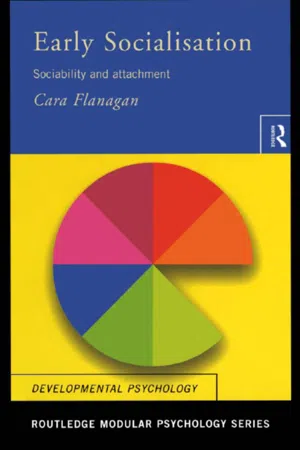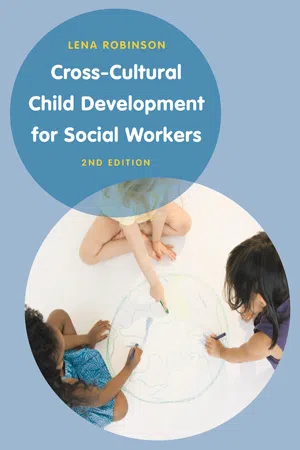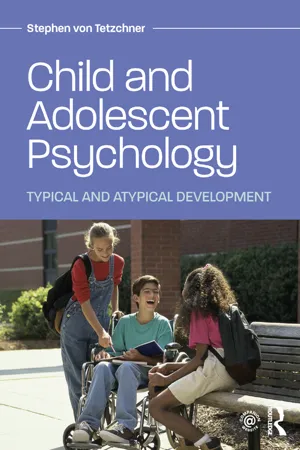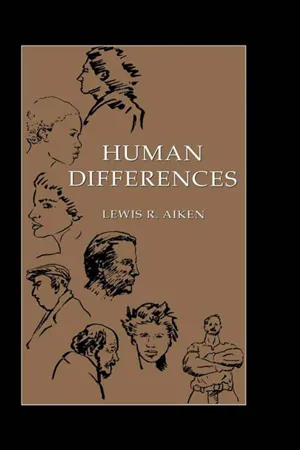Cultural Variations in Attachment
Cultural variations in attachment refer to the differences in attachment patterns and behaviors across different cultures. These variations can be influenced by cultural norms, values, and child-rearing practices. Research has shown that attachment styles may differ between cultures, highlighting the importance of considering cultural context when studying attachment.
6 Key excerpts on "Cultural Variations in Attachment"
- eBook - ePub
Early Socialisation
Sociability and Attachment
- Cara Flanagan(Author)
- 2002(Publication Date)
- Routledge(Publisher)
...7 Social and cultural variations Introduction The picture of early socialisation which has been presented so far has largely overlooked one critical factor. It only represents the approach of one culture to childrearing. The view of attachment applies mainly to a particular social group (middle-class parents), to a particular ethnic group (White Europeans) and to a particular historical period (the twentieth century). Why do I say this? Because much of the research has involved the behaviour and attitudes of White, middle-class Europeans and it is entirely from this century. In this chapter we will consider some examples of what is similar and what is different across social and cultural groups. This will enable us to assess to what extent the attachment process is universal and innate, or to what extent it is strictly a cultural phenomenon. We might also note that cross-cultural research enables us to gain insights into our own cultural practices and to develop a less ethnocentric view of human behaviour. What is ‘cultural variation’? The term ‘culture’ here refers to a set of rules, morals and methods of interaction that bind a group of people. These rules, morals and so on are the products of socialisation, that is we learn them through our social interactions with other members of our culture. Within any culture there are ‘sub-cultures’. We might consider that different social classes are in effect sub-cultures, and therefore can include class differences within the context of cultural variation. We would expect the wider issue of childrearing to be related to culture and sub-culture because childrearing methods are the processes by which children are socialised...
- eBook - ePub
Cross-Cultural Child Development for Social Workers
An Introduction
- Lena Robinson(Author)
- 2020(Publication Date)
- Bloomsbury Academic(Publisher)
...Childrearing practices vary across cultures, which can impact the attachment processes between caregivers and children (Howes & Spieker, 2008). There is evidence that broad cultural patterns of individualism-collectivism foster different social competencies. For example, secure attachment in Japanese culture leads to interdependent social relationships, adherence to social norms, and self-esteem based on other’s approval. In Western cultures, secure attachment patterns are more probably associated with autonomy, self-reliance, and self-esteem based on personal competence, reflecting individualistic values (Cheng & Kwan, 2008; Morelli & Rothbaum, 2007). Children ‘expressing these social behaviours are considered healthy and competent in their own respective cultures, but not necessarily in another’ (Gardiner and Kosmitzki, 2014). Practitioners ‘need to be respectful and sensitive towards varied patterns of care-giving influenced by the cultural norms within different communities. The key consideration is the assessment of whether or not basic needs are reliably met’ (Daniel, 2010, p. 25). Brown et al. consider that attachment goals from a Western perspective ‘move the individual from reliance on a safe base to personal exploration encompassing a wider and wider periphery, with the goal of autonomy. However, in collectivist cultures, for example, the goal of the caretaker would be more apt to encourage mutual effort rather than reliance on self’ (2008, p. 24). Minuchin (2002) extended the application of attachment theory into the realm of family therapy, proposing that attachment of a child might not only revolve around one person but also include extended family networks and dynamics, playing an important role across cultures. Minuchin also pointed out that family therapists must take into account family structures, as they differ from one culture to another. It is therefore important to think of attachment in the cultural context of the situation...
- eBook - ePub
- Willem Koops, Frank Kessel, Willem Koops, Frank Kessel(Authors)
- 2020(Publication Date)
- Routledge(Publisher)
...In many societies, multiple care is a widespread and normal practice. In sum, ethnographic studies of child-rearing beliefs, goals, and practices in different societies have challenged the universalistic claims of attachment theory and its focus on the mother-infant dyad. In addition, regardless of the accuracy of any particular study or the validity of any specific insight, the anthropological work has made clear that context matters when studying child-rearing practices, child development, and emotions in human societies. To explain behavior and affects, researchers must understand the meanings they acquire within a particular culture. As both anthropological and historical works have shown, child rearing practices depend on conceptions of the self, personhood, and the social good that vary among different societies and that have changed over time (Koops, 2003; Morelli et al., 2017). Conclusion In this paper I have examined some powerful criticisms that anthropologists and cultural psychologists leveled against attachment theory from its inception to the present. From Mead to current researchers cross-cultural investigations have demonstrated the existence of various visions of children and development. As Levine and Norman have put it: ‘there is a wider range of pathways to normal emotional development than has been imagined in attachment theory’ (2008, p. 139). Anthropologists have revealed the variability and diversity in conceptions of childhood and practices of childcare by studying children in context...
- eBook - ePub
Emerging Topics on Father Attachment
Considerations in Theory, Context and Development
- Lisa A. Newland, Harry S. Freeman, Diana D. Coyl, Lisa A. Newland, Harry S. Freeman, Diana D. Coyl(Authors)
- 2014(Publication Date)
- Routledge(Publisher)
...Thus, it is necessary to study the influences of both distinguishable groups of mental representations in the development of socio-cognitive and emotional processes in children. It is essential, therefore, that in developmental studies we examine the patterns of relationship between attachment to fathers and related developmental outcomes. This is particularly important for identifying patterns that are unique to the father-child, as opposed to the mother-child relationship, especially in middle and late childhood (Richaud de Minzi, 1991, 2005, 2006). This study found that child gender was an important consideration when examining mother-child and father-child relationships, especially when taking into account cultural patterns that influence gender roles of children and parents. Cultural norms, which establish the role of each parent in children's socialisation, are very different from one culture to another, beyond the universal basis of human attachment relationships. Limitations and future research directions A limitation of the present study is its correlational nature, which does not allow exploration of causal relationships. It was carried out within a specific cultural niche and in a specific age range: middle and late childhood. Future research efforts directed at studying mother and father attachment in the prediction of diverse processes in different stages of children's development within a variety of cultural groups will be necessary. The importance of a culture-sensitive approach to establish universal and specific pathways to children's developmental outcomes cannot be understated. Acknowledgements This study was supported by a grant from the National Council of Scientific and Technological Research of Argentina (CONICET)...
- eBook - ePub
Child and Adolescent Psychology
Typical and Atypical Development
- Stephen von Tetzchner(Author)
- 2018(Publication Date)
- Routledge(Publisher)
...Parental reactions to attachment behavior are based on the parents’ own working models as well as the experiences with their child, which leads to individual differences in availability (George and Solomon, 2008). However, just as in the case of early and later measures of attachment, only modest correlations have been found between mothers’ attachment in their own childhood and the attachment type of their children. The one exception is mothers with early insecure-disorganized attachment (category D) – more than half had children who fell into category D (Raby et al., 2015), suggesting that it was the mothers’ own highly deviant development that most clearly affected the children in this group. The attachment relationships of children with more conventional attachment histories can be affected by many factors. However, attachment behavior is thought to be mainly a result of experience, and genes do not seem to have a significant impact on the development of attachment relationships (Raby et al., 2013). CULTURAL DIFFERENCES Ainsworth (1967) did her first studies of attachment in Uganda, and studies indicate that chil-dren’s behavior in the Strange Situation can be classified according to the same categories in all cultures. However, cultural differences in care-giving patterns are mirrored in the distribution of attachment types. Infants among the Aka people in the Central African Republic, for example, have more than 20 different caregivers every day. One-year-olds of the Nso tribe in the Northwest Region of Cameroon do not react to being picked up by a stranger, and will readily follow the stranger’s initiative (Otto et al., 2014). Israeli kibbutzim practice communal child rearing, and children sleep away from their parents (Sagi-Schwartz and Aviezer, 2005)...
- eBook - ePub
- Lewis R. Aiken(Author)
- 2014(Publication Date)
- Psychology Press(Publisher)
...Pioneer child development researchers such as Arnold Gesell focused on maturation and readiness and collected norms for the appearance of specific perceptual, motor, cognitive, social, and emotional behaviors. However, these norms are only averages, and there is a great deal of individual variation around them. Appearance of the first steps and the first words, for example, can vary extensively with the sex, nationality, and physical characteristics of the child. Developmental norms and theories are still important to child psychologists. However, rather than embracing more general theories of development, emphasis in recent years has been on the analysis of single processes. One process that has occasioned a great deal of interest and appears to be especially important to social development is attachment. Attachment The strong affectional tie that binds a person to an intimate companion was designated by Bowlby (1982/1969) as attachment. Associated with feelings of attachment is a need for body contact, observable in most mammals, and deprivation of which can have profound physiological and psychological consequences. Both psychoanalytic and learning theorists have viewed attachment to and love of an infant for its mother as associated with the feeding situation. Research by Harry Harlow and his associates (Harlow, 1958; Harlow & Zimmerman, 1959) showed that, when given a choice, young rhesus monkeys chose to spend more time on a terry cloth-covered monkey model than on a wire-covered model, although they received food from the latter. The fact that contact with the cloth-covered monkey mother decreased the fears and increased the feelings of security of young monkeys was revealed when the monkeys were placed in a strange situation or exposed to a fear stimulus...





